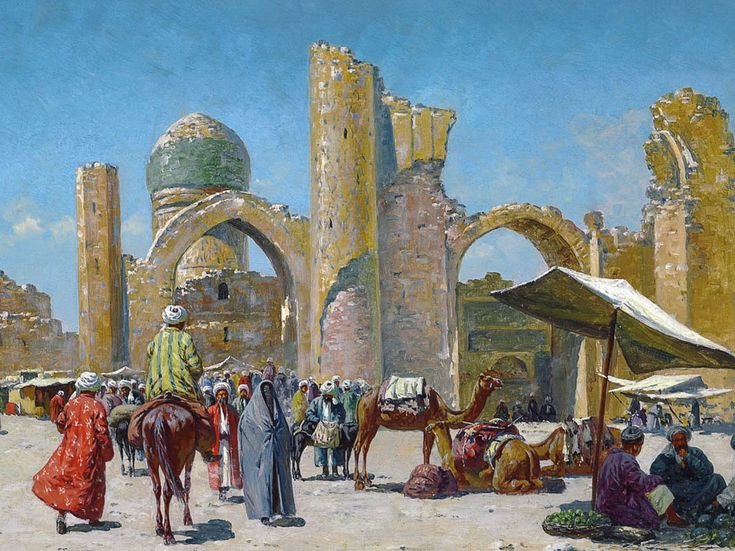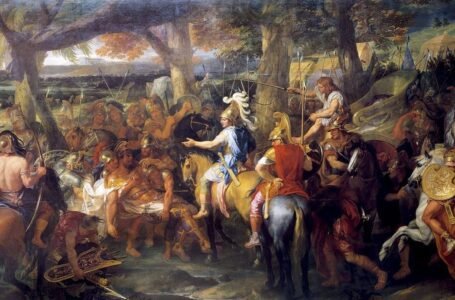The Mongol Empire: History, Culture, and Legacy

As soon as the Russian conquest of the Caucasus was completed in the late 1850s, the Russian Ministry of War began to send military forces against the Central Asian khanates. Three major population centers of the khanatesÑTashkent, Bukhara, and SamarkandÑwere captured in 1865, 1867, and 1868, respectively. In 1868 the Khanate of Bukhara signed a treaty with Russia making Bukhara a Russian protectorate. Khiva became a Russian protectorate in 1873, and the Khokand Khanate finally was incorporated into the Russian Empire, also as a protectorate, in 1876. By 1876 the entire territory comprising present-day Uzbekistan either had fallen under direct Russian rule or had become a protectorate of Russia. The treaties establishing the protectorates over Bukhara and Khiva gave Russia control of the foreign relations of these states and gave Russian merchants important concessions in foreign trade; the khanates retained control of their own internal affairs. Tashkent and Khokand fell directly under a Russian governor general. (Photo by: Pictures from History/Universal Images Group via Getty Images)
The Mongol Empire, founded by Genghis Khan in the early 13th century, stands as the largest contiguous land empire in history, stretching from the Pacific Ocean to Eastern Europe. Known for its unparalleled military power, efficient governance, and significant cultural exchanges, the empire reshaped world history by influencing trade, administration, and technology across vast regions. Beyond its conquests, Mongol culture and traditions played a crucial role in shaping Eurasian civilisation, leaving behind a complex legacy that continues to be studied today.
Origins and Rise of the Mongol Empire
Before the rise of Genghis Khan, the Mongols were a loose confederation of nomadic tribes inhabiting the harsh steppes of Mongolia. These tribes relied on herding, hunting, and warfare to survive in an unforgiving environment characterised by extreme climates and scarce resources. They were skilled horsemen, moving swiftly across vast landscapes, engaging in skirmishes with rival clans, and forming temporary alliances dictated by necessity. Leadership among them was often contested, with power shifting through battles and betrayals.
Amid this fragmented world, a boy named Temujin was born around 1162. His father, a minor Mongol chieftain, was assassinated when Temujin was still a child, leaving his family abandoned by their clan and struggling to survive. Enduring hardship, he learned the value of loyalty and strategic alliances, gradually amassing a following of warriors who recognised his leadership skills. Through a combination of diplomacy, warfare, and a keen understanding of human nature, Temujin consolidated power, uniting the Mongol tribes after years of internal conflict. In 1206, he was proclaimed Genghis Khan, meaning “Universal Ruler,” marking the birth of an empire that would soon extend far beyond the Mongolian steppe.
Military Strength and Expansion
The Mongol military was unlike any other of its time, built upon mobility, discipline, and innovative tactics. Unlike the static, heavily armoured armies of Europe and the Middle East, Mongol warriors relied on their superior horsemanship and highly efficient composite bows, which could fire arrows with great accuracy and power over long distances. Their ability to cover enormous distances at incredible speed allowed them to strike with devastating force, withdraw before enemies could retaliate, and return for another assault when least expected.
Genghis Khan revolutionized Mongol warfare by organising his army into a decimal system, where soldiers were divided into units of ten, a hundred, a thousand, and ten thousand. Leadership was granted based on ability rather than noble lineage, ensuring that only the most competent warriors held positions of command. Psychological warfare also played a crucial role in Mongol strategy. Cities that resisted were often completely destroyed, their populations massacred as a warning to others. However, those who surrendered were spared and often integrated into the Mongol administration. This combination of terror and pragmatism made their conquests swift and highly effective.
Under Genghis Khan, the Mongols overran the Jin Dynasty in northern China, the Khwarezmian Empire in Persia, and much of Central Asia and Russia. After his death in 1227, his successors continued expanding the empire. Ögedei Khan led invasions into Eastern Europe, reaching as far as Poland and Hungary. Mongke Khan pushed into the Middle East, sacking Baghdad in 1258 and bringing an end to the Abbasid Caliphate. Kublai Khan completed the conquest of China, establishing the Yuan Dynasty in 1271 and becoming the first foreign ruler to govern all of China. At its height, the Mongol Empire covered over 33 million square kilometres, ruling over a diverse population of more than 100 million people.
Mongol Culture and Governance
Despite their fearsome reputation in battle, the Mongols were highly pragmatic rulers who understood the need for effective governance over such a vast empire. Genghis Khan introduced a legal code known as the Yassa, which enforced strict laws against theft and betrayal while promoting religious tolerance. Unlike many contemporary empires that persecuted religious minorities, the Mongols allowed freedom of worship, integrating Buddhism, Islam, Christianity, and traditional shamanistic practices into their rule.
Their society remained deeply rooted in nomadic traditions. They lived in yurts, portable felt-covered tents, and continued to rely on their herds for food, clothing, and trade goods. However, as they expanded, they absorbed and adapted to the customs of the settled peoples they ruled. They encouraged scholars, engineers, and merchants from different cultures to collaborate, fostering a unique blend of traditions and innovations.
Mongol women enjoyed more freedom and influence compared to their counterparts in many other societies. They could own property, manage households, and even participate in political decisions. Some, such as Töregene Khatun and Sorghaghtani Beki, played significant roles in ruling Mongol territories after the deaths of their husbands. Unlike in many feudal societies where women were confined to domestic roles, Mongol women often had a say in governance and could even lead armies if necessary.
The Pax Mongolica and Cultural Exchange
During the Pax Mongolica, or “Mongol Peace,” the empire provided stability and security across Eurasia, facilitating an unprecedented level of trade, travel, and cultural exchange. The Mongols revitalised the Silk Road, ensuring safe passage for merchants, diplomats, and scholars. This period saw the movement of goods, technologies, and ideas across continents, linking Europe, the Middle East, India, and China.
Trade flourished as commodities such as silk, spices, gunpowder, and paper money traveled from East to West. Knowledge also spread rapidly—Islamic medicine and astronomy influenced Chinese and European sciences, while Chinese innovations such as printing and gunpowder weapons reached Europe. Even traveler like Marco Polo ventured to the Mongol court, documenting their experiences and introducing the West to the splendour of Kublai Khan’s empire.
The Fall of the Mongol Empire
Despite its vast power, the Mongol Empire eventually fragmented due to a combination of internal and external pressures. The Mongols lacked a stable system for selecting rulers, leading to succession struggles that weakened their unity. Additionally, local resistance and revolts emerged as conquered peoples sought to regain independence. The devastating impact of the Black Death in the 14th century further weakened trade and economies, hastening the empire’s decline.
By the mid-14th century, the empire had fractured into four major khanates: the Yuan Dynasty in China, the Ilkhanate in Persia, the Chagatai Khanate in Central Asia, and the Golden Horde in Russia and Eastern Europe. The Yuan Dynasty was overthrown by the Ming in 1368, the Ilkhanate collapsed in 1335, and the Chagatai Khanate gradually declined. The Golden Horde persisted for a time but ultimately fell as Moscow rose to power in the 15th century.
Legacy of the Mongol Empire
Although the Mongol Empire ultimately disintegrated, its influence on world history remains profound. By uniting vast regions under one rule, the Mongols paved the way for future global trade and exploration. They introduced innovations in military strategy, governance, and diplomacy that shaped later empires, including the Ottomans, Mughals, and Russians.
The Mongols also facilitated the spread of ideas, technology, and culture between East and West, influencing developments in cartography, commerce, and communication. The Russian state, for instance, inherited administrative and military strategies from Mongol rule, while European nations gained access to Asian advancements that would later contribute to the Renaissance.
Conclusion
The Mongol Empire was not merely a force of conquest but also a driver of global connectivity and cultural exchange. It demonstrated the power of organisation, adaptability, and strategic governance, reshaping the world in ways that continue to be felt today. While remembered for their military conquests, the Mongols also laid the foundation for a more interconnected world, influencing trade, diplomacy, and technological development across continents. Their legacy endures in modern geopolitics, trade networks, and cultural traditions that span Eurasia.


